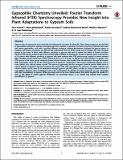Por favor, use este identificador para citar o enlazar a este item:
http://hdl.handle.net/10261/103072COMPARTIR / EXPORTAR:
 SHARE SHARE
 CORE
BASE CORE
BASE
|
|
| Visualizar otros formatos: MARC | Dublin Core | RDF | ORE | MODS | METS | DIDL | DATACITE | |

| Campo DC | Valor | Lengua/Idioma |
|---|---|---|
| dc.contributor.author | Palacio, Sara | - |
| dc.contributor.author | Aitkenhead, Matt | - |
| dc.contributor.author | Escudero, Adrián | - |
| dc.contributor.author | Montserrat-Martí, Gabriel | - |
| dc.contributor.author | Maestro Martínez, Melchor | - |
| dc.contributor.author | Jean Robertson, A. H. | - |
| dc.date.accessioned | 2014-10-09T07:32:39Z | - |
| dc.date.available | 2014-10-09T07:32:39Z | - |
| dc.date.issued | 2014 | - |
| dc.identifier | doi: 10.1371/journal.pone.0107285 | - |
| dc.identifier | issn: 1932-6203 | - |
| dc.identifier.citation | PLoS ONE 9(9): e107285 (2014) | - |
| dc.identifier.uri | http://hdl.handle.net/10261/103072 | - |
| dc.description.abstract | Gypsum soils are among the most restrictive and widespread substrates for plant life. Plants living on gypsum are classified as gypsophiles (exclusive to gypsum) and gypsovags (non-exclusive to gypsum). The former have been separated into wide and narrow gypsophiles, each with a putative different ecological strategy. Mechanisms displayed by gypsum plants to compete and survive on gypsum are still not fully understood. The aim of this study was to compare the main chemical groups in the leaves of plants with different specificity to gypsum soils and to explore the ability of Fourier transform infrared (FTIR) spectra analyzed with neural network (NN) modelling to discriminate groups of gypsum plants. Leaf samples of 14 species with different specificity to gypsum soils were analysed with FTIR spectroscopy coupled to neural network (NN) modelling. Spectral data were further related to the N, C, S, P, K, Na, Ca, Mg and ash concentrations of samples. The FTIR spectra of the three groups analyzed showed distinct features that enabled their discrimination through NN models. Wide gypsophiles stood out for the strong presence of inorganic compounds in their leaves, particularly gypsum and, in some species, also calcium oxalate crystals. The spectra of gypsovags had less inorganic chemical species, while those of narrow gypsum endemisms had low inorganics but shared with wide gypsophiles the presence of oxalate. Gypsum and calcium oxalate crystals seem to be widespread amongst gypsum specialist plants, possibly as a way to tolerate excess Ca and sulphate. However, other mechanisms such as the accumulation of sulphates in organic molecules are also compatible with plant specialization to gypsum. While gypsovags seem to be stress tolerant plants that tightly regulate the uptake of S and Ca, the ability of narrow gypsum endemisms to accumulate excess Ca as oxalate may indicate their incipient specialization to gypsum. © 2014 Palacio et al. | - |
| dc.description.sponsorship | The authors thank M.J. Albert, R. Milla, P. Fustero and A. Lamana for help with plant sampling and processing, to R. Hill for running the FTIR spectrometer, to E. Pérez-Fernández for assistance with FTIR figures and to J. F. Mota and an anonymous Referee for helpful comments on earlier versions of the manuscript. | - |
| dc.publisher | Public Library of Science | - |
| dc.rights | openAccess | - |
| dc.title | Gypsophile chemistry unveiled: Fourier transform infrared (FTIR) spectroscopy provides new insight into plant adaptations to gypsum soils | - |
| dc.type | artículo | - |
| dc.identifier.doi | 10.1371/journal.pone.0107285 | - |
| dc.relation.publisherversion | http://dx.doi.org/10.1371/journal.pone.0107285 | - |
| dc.date.updated | 2014-10-09T07:32:39Z | - |
| dc.description.version | Peer Reviewed | - |
| dc.language.rfc3066 | eng | - |
| dc.identifier.pmid | 25222564 | - |
| dc.type.coar | http://purl.org/coar/resource_type/c_6501 | es_ES |
| item.openairetype | artículo | - |
| item.grantfulltext | open | - |
| item.cerifentitytype | Publications | - |
| item.openairecristype | http://purl.org/coar/resource_type/c_18cf | - |
| item.fulltext | With Fulltext | - |
| Aparece en las colecciones: | (IPE) Artículos | |
Ficheros en este ítem:
| Fichero | Descripción | Tamaño | Formato | |
|---|---|---|---|---|
| Palacio_et al._ Gypsophile Chemistry Unveiled_journal.pone.0107285.pdf | 950,99 kB | Adobe PDF |  Visualizar/Abrir |
CORE Recommender
PubMed Central
Citations
12
checked on 16-abr-2024
SCOPUSTM
Citations
67
checked on 17-abr-2024
WEB OF SCIENCETM
Citations
56
checked on 26-feb-2024
Page view(s)
627
checked on 19-abr-2024
Download(s)
296
checked on 19-abr-2024
Google ScholarTM
Check
Altmetric
Altmetric
Artículos relacionados:
NOTA: Los ítems de Digital.CSIC están protegidos por copyright, con todos los derechos reservados, a menos que se indique lo contrario.
